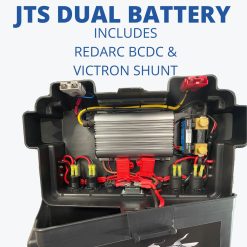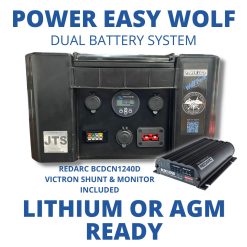12 Volt Technical Articles
What 12 Volt System is right for you?
1. Size of System
2. Advantages of 12V
3. Disadvantages of 12V
4. Costs of 12V
5. Conclusion
1. Size of System
The most important aspect of 12v is the size of the system. If you want to run a a 40L fridge and led lights for the weekend, then a 100ah Lithium system would be just fine. If you want to run a 80L fridge, LED lights and separately, coffee machine, charge laptops, phones, tablets, CPAP machine and induction cooker, your energy requirements would be much higher and you would need a larger system, perhaps a 400ah lithium system with a 2000W inverter would be more suitable.
The first step is to calculate how many watts of energy you will be using each day. This is the amount of power you want to end up with. I suggest you take a few minutes and make a list of the appliances that you will be using, check each appliance and add up the number of watts.
Watt hour (Wh) represent the estimated amount of energy an electrical appliance consumes in one hour.
You can use this formula to calculate watts that your system needs:
Watts = Amps x Voltage
Example:
Fridge 24Watts
24Watts = 2amps x 12 volts
LED Lights 1Watt
1 Watt = 0.0833 amps x 12 volts
Total 25Watts
If the fridge and LED lights run 24 hours then total Watt hours used is 25Watts x 24 hours = 600 Wh
Once we know the total Watt hours we can determine what battery size would be suitable.
We use this formula to calculate Amp hours
Watt hours divided by Voltage = Amp hours
Example:
600 Wh divided by 12 volts = 50 Amp Hours
If we use a 100Ah Lithium battery with 90Ah useable capacity, this would have enough power to run your fridge and led lights for at least 1.8 days
Second step is to put back into the system as much power as we possible can.
We can do this with solar and power from the alternator.
To charge the battery efficiently we use a DC-DC Charger.
The charger will charge the battery at a maximum amperage which is usually displayed on the charger.
Example:
A Redarc BCDC1225D Charger will charge at 25 Amps per hour, therefore will charge a 100Ah Lithium within 4 hour.
If you drive 4 hours you will be able to recharge your system completely.
We can also charge the system using a solar. We can use a Solar Charger or a DC-DC Charger that also has a solar charger built in.
Each Solar Panel has a maximum power output usually measured in Watts.
Example:
180W Enerdrive panel can produce up to 180W per hour in perfect conditions.
This is equivalent to 15 Amp hours. 180Wh divided by 12 volts = 15Ah.
The number of usable daylight hours is 5 hours.
Therefore 5 x 180W = 900 Watts
The system overall is using 600W and is being replaced by 900W. This system is net positive. You would be able to run this system for an extended period.
2. Advantages of 12V
The advantage of using a 12V system is that you can power appliances, like a fridge and LED lights, when you are off grid and don’t have access to 240V mains power. Having access to cold storage for food and lighting can extend your trip and make it more enjoyable.
- Simple to Setup
- Inexpensive over the long term
- Relative Safe
- Reliable
- Compact
- Allows you to go Off Grid
3. Disadvantages of 12V
The disadvantage of a 12V system is that you cannot run 240V appliances without using an Inverter. 240V appliances generally consume more energy and quickly drain the battery.
- Limited 12V appliances available
- Costly when increasing capacity or adding 240V Inverter
- Limited amount of appliances that can be used at the same time
- Limited distance when using appliances due to voltage drop
- Relies on charging from alternator, solar or generator
4. Costs of 12V
A 12V system can be inexpensive or costly depending on your power requirements. If you can live without an inverter you will save
A simple system could be a SLA (Sealed Lead Acid), or AGM (Absorbed Glass Matt) Deep Cycle Battery 120 AH in a battery box with a Voltage Sensitive Relay to prevent the start battery draining. This system relies on getting power from the alternator. The usable Ah are generally 50% of battery capacity, which means a 120Ah battery can only supply 60Ah. Because there is no dedicated DC-DC Charger the battery will never be charged to full capacity.
A system like this you would expect to pay around $1000.
A standard system could be a 100 AH Lithium battery in a Power Easy battery box which has a REDARC BCDC1225D integrated so that you can charge from the alternator and a solar panel. The REDARC BCDC1225D charges the battery to full capacity and power from the solar panels are maximised using MMPT (Maximum power point tracker) controller.
A system like this you would expect to pay around $2100
A superior system could be 200 AH of Lithium in a Power Easy Expedition box which is integrated with DC-DC Charger, Solar Charger, 240V Charger, Inverter, Bluetooth Shunt (measuring State of Charge) and accessories.
A system like this you would expect to pay around $4000.
5. Conclusion
No matter what your budget you can get a 12 volt system that gives you the freedom to travel further and stay longer.
If you have any questions please contact us on 1300 377 128 or drop into our shop at 3175 Old Gympie Rd Landsborough QLD 45503.
Are you looking for a portable dual battery solution? Check out our range of Power Easy Dual Battery Systems
Dual Battery Systems
Dual Battery Systems
Battery Chargers
Dual Battery Systems
Dual Battery Systems
JTS Power Easy Dual Battery System Combo Kits Select your Preferences
Dual Battery Systems
Battery Chargers















